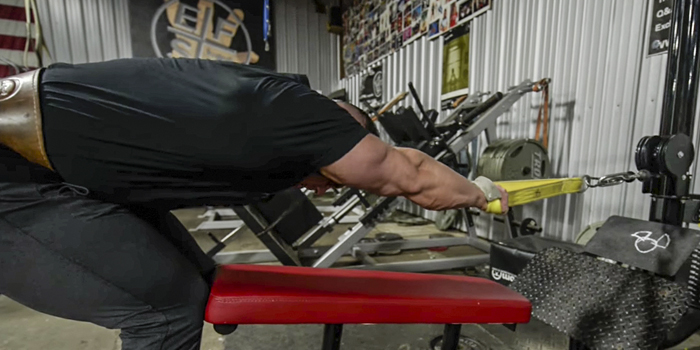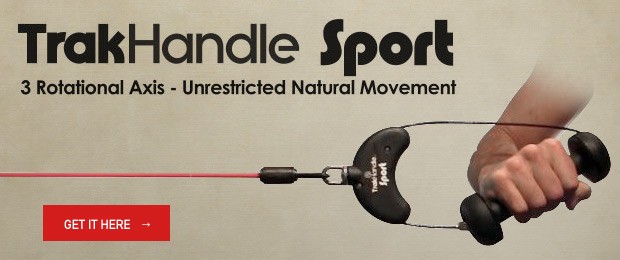
I realize the title of this article will be a bit of a turn-off for diehard lovers of iron. If you’re one of those guys who thinks anything outside of plates on a bar is blaspheme, give me five minutes to convince you otherwise. Skeletal muscle hypertrophy holds value from a strength, body composition, and especially from a bodybuilding perspective. A muscle rarely increases in size without strength following. The more muscle you carry, the more calories you burn, hence the improved body composition factor (unless your diet is awful). And finally, yes, bodybuilding success is very much tied to muscularity.
RECENT: Married to a Bodybuilder: Three Women Share Their Support Role Perspectives
To that end, I’m not telling you to jettison basic, compound exercises. Use them to lay the foundation for your training. However, if you care about hypertrophy, the following five exercises should show up in your workouts more frequently than a vegan splurges on a ribeye.
1. Dante Rows
Tools:
Why: Dante Rows, named after Dante Trudel (Doggcrapp Training), is the individual to whom I attribute this exercise. It works by isolating the lats through a long range of motion. I consider it a superior, modern day equivalent to the old chain-driven Nautilus pullover machine made famous by Dorian Yates.
Key Points: Utilize carabiners to avoid walking the weight back to the point that the weight stack slams into the top of the pulley apparatus when pulling to the contracted position. Get a good stretch when extending your arms before driving your elbows back towards your knees, rounding your back, and flexing your lats as hard as possible before accentuating the negative.
2. Incline Pronated Grip Cable Flyes
Tools: Cable Crossover Machine
Why: I derived this variation from pronated dumbbell flyes prescribed by John Meadows in a former training program he developed. I found the cables provide a greater amount of continuous tension, particularly during the peak contraction.
Key Points: The amount of weight used on any form or a pronate fly is not the focus. Lighter weight is safer on the shoulder joint and will allow a superior contraction at the top. Keep your sternum lifted throughout the movement with a slight bend in the elbows and accentuate the contraction on every rep.
3. Seated Pulley Lying Cable Curls
Tools:
Why: I’m not sure of the origin of this exercise, but I came up with it one day while suffering from a jacked up lower back. The value of this technique stems from the fact it removes spinal compression and forces nearly perfect form compared to standing barbell curls.
Key Points: Keep your elbows pinned to your sides while curling the weight and avoid allowing them to move forward during the peak contraction to minimize recruitment of the anterior deltoids. Consciously extend your arms fully at the bottom of the movement before initiating the curl with your biceps.
4. Modified Rack Pull Pulley Rows
Tools:
Why: Well, if you have a jacked up lower back like me, this exercise allows you to work your erectors, lats, and traps with less spinal compression than a traditional deadlift or rack pull. Sometimes progress looks like training smarter instead of harder.
Key Points: Begin by contracting your lats while maintaining a flat back. Hinge from the hip joints and contract your entire back when pulling. Ensure tension is maintained on your lats while controlling the eccentric phase of each rep.
5. Cable Side Laterals
Tools: Cable-Crossover Machine
Why: Cables allow continuous tension more than your standard dumbbell. Performing these with the cables behind your back targets the medial deltoid and provides a better stretch at the bottom without removing the tension.
Key Points: This exercise is all about the pump and the burn, so don’t go heavy chasing a PR. Rep volume is important, even though you’ll hate life once you get above the 15 rep range on your third and fourth sets.
Conclusion
I relate to the challenge and joy that comes from training the major compound movements with heavy weight but don’t shortchange your growth by refusing to step outside the platform. The previously mentioned cable exercises work great as staple finishing movements and often make their way into both my primary and secondary workouts. If the major lifts lay the foundation, cable exercises sprinkled into a program can refine your physique, spark new growth, and add the finishing touch to a great physique.











All the best,
Mark
Glad you enjoyed the article and hope you see some benefit employing the techniques in the gym.
All the best,
Mark